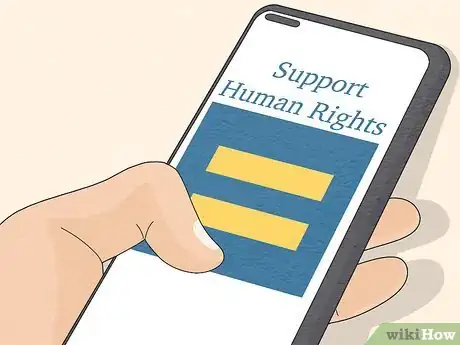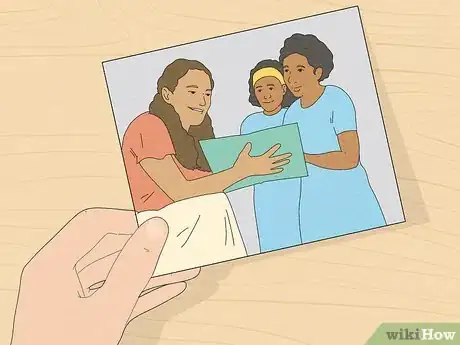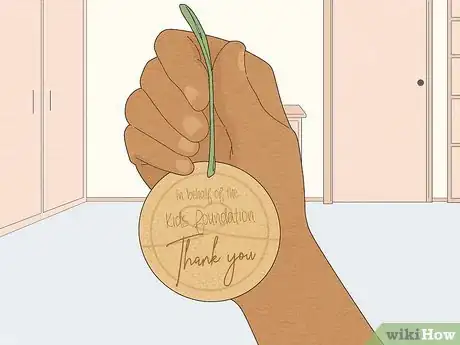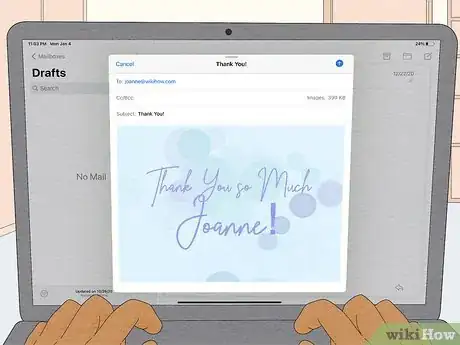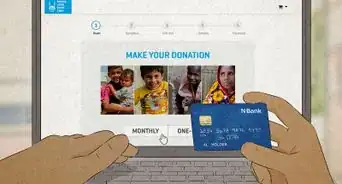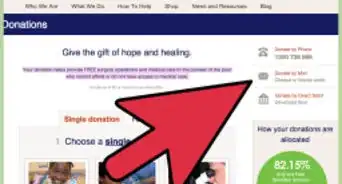This article was co-authored by wikiHow Staff. Our trained team of editors and researchers validate articles for accuracy and comprehensiveness. wikiHow's Content Management Team carefully monitors the work from our editorial staff to ensure that each article is backed by trusted research and meets our high quality standards.
This article has been viewed 123,032 times.
Learn more...
Giving a gift can be exciting. It brings joy to both the giver and receiver. When your gift for someone is a donation made in their name, this gift keeps on giving. It may be possible, however, for the recipient of your gift to experience a little confusion. As such, it might take some creativity and even a little persuasion on your part to help them understand the merits of such a gift. Once they do, you will both experience the bliss of generosity!
Steps
Appealing to Logic
-
1Explain their donation in terms of numbers. For the more logically minded person on your list, use numbers to represent the impact of their gift. Many charities will explain in numbers what a specific dollar amount can achieve. Include this information in your gift.
- For example, if you are donating to a food bank, explain that their generous donation will feed X number of people for Y number of days.
-
2Make a logical argument. Ask the person the following two questions: (1) "Do you think that you would like getting a gift that will make you feel better?" (2) "Do you think that giving a donation to a charity will make you feel better?" If the answer is "yes" to both questions, you can simply announce what your gift is.Advertisement
-
3Highlight the convenience of a "virtual" gift. This gift will not take up any space in their home. They won’t have to decide what to do with it when they move. They won’t have to spend any time or energy maintaining this gift. You can highlight some of these convenient qualities of giving a virtual gift!
- For example, you can say: "I'd like to give you something of very high quality that takes none of your space and wastes none of your time. Guess what it is?"
- It may help to list some of these qualities jokingly, which can lessen the awkwardness. But your message of convenience will still be heard.
-
4Tell them you thought long and hard about this. Explain your thought process. This is an especially strong argument for a recipient who is relatively affluent; someone who already “has everything.”
- Explain that you spent a lot of time brainstorming what to get them.
- List some of the items you considered.
- Finally, explain why this was the best choice.
-
5Explain your financial situation. If money is tight for you this year, giving donation-based gifts can be a way to make your gifts go farther. If this is your case, outline this reality for your friend. It will shift to focus away from what they “didn’t get,” and back toward the actual spirit of giving.[1]
- If you ordinarily give physical gifts and donate to charity around the holidays, you can save money by combining the two.
- Most donations qualify as tax-deductions, which can help you out if money is tight.
Appealing to Emotions
-
1Drop clues ahead of time. You can minimize bewilderment by dropping some clues to the recipient before you give them a gift. This will diffuse any disappointment they might feel in the moment. If this is for Christmas, or another mutual gift-giving holiday, this may also cause them to reevaluate what they are giving to you (which is only fair).[2]
- You can say, “Have you ever heard of people giving donations in someone’s name instead of physical gifts? I think that’s pretty cool. We all have way too much stuff anyway.”
-
2Make it personal. You want the recipient to have an emotional connection with this gift. As such, select a charity that will be meaningful to them. By donating to charity that they believe in, the large-scale generosity of the gift will be clear. What’s more, the personalized nature of the gift will show that you put thoughts into it. This will make it much easier to explain your gift.
- If they are vegetarian or vegan, consider donating to an animal rights group.
- If they support LGBTQ rights, perhaps donate to Human Rights Campaign or a similar organization.
-
3Connect the gift to a personal memory. Beyond simply connecting the charity to something they like, can you select something that is meaningful to you both, or to your relationship? What special memories do you share with this person? Do they involve food? Do they involve the outdoors or animals? Choose a charity that connects with those memories.[3]
- Include a message that explains this connection when you present them with the gift.
- You could say something like, “Remember when Grandma used to bake extra loaves of banana bread and bring them to the church before Easter? That inspired me to want to feed the hungry, and I thought it would make you happy to support that cause, too.”
-
4Give them a choice. On a neurological level, giving makes people feel happy. This is what you are giving! However, studies show that when a person has no control over the giving, the happiness effect is minimized.[4] Many websites (such as DonorsChoose.org) allow the recipient to select the charity they want. This makes it much easier to explain your gift, and furthermore, the recipient will get a bigger happiness boost from the act of giving!
-
5Use imagery. Don’t simply tell the recipient what their donation is doing. Show them! Request an image directly from the charity group or try to download one from their website. Images appeal to a different part of the brain. A powerful image can influence the recipients opinion more effectively than words alone.[5] Print out the image and give it to the recipient.
- If the charity is working to feed hungry bellies, show an image of someone being fed.
- If the charity is building school for young women, find an image of the women being helped.
-
6Prepare yourself for disappointment. Despite all of these tactics, it is still possible that the recipient will be disappointed with their gift. Try to emotionally prepare for this reaction. Remind yourself of the positive impact of your gift. Most likely, your recipient will get over their initial dismay and come to appreciate the value of such a gift.
Packaging Your Gift
-
1Compose a personalized message. Drawing on your relationship with the recipient, create a message that includes everything you think would be relevant to them. Communicate personal messages, explain thought processes, include numbers and data on how the donation will be used, and/or share images of those being helped. Which methods do you think will be most meaningful and effective to you recipient?
- Aim for including one emotional appeal (e.g., personal story or image) and one logical appeal (e.g., numbers/data or explanation of thought process.)
-
2Buy a card. In order to communicate the message of your gift, you will want to give them a nice card. Inside this card, you will include your personalized message. Be sure to include some sort of receipt or verification of the donation you made.
- Use a neat and legible handwriting.
- Print out a receipt of the donation and tape it inside.
- Don’t forget to sign the card!
-
3Make a card. Rather than buying a card at the store, you can up the ante on your gift by creating a hand-made card. This further highlights the personal and thoughtful nature of your gift.
- Take a piece of paper (printer paper, construction paper, or looseleaf notebook paper) and fold in half from top to bottom.
- Next, fold it from left to right. Here is the base for your card.
- Decorate the front with images from magazines, or draw something with markers.
- Include your personalized message and proof of donation inside.
- Once again, don’t forget to sign the card!
-
4Include a memento of their donations. Many charities offer Christmas ornaments, stickers, or other small tokens that signify the donation. Wrap up this token and present it to them. This will give them a small physical gift to open, as well as something they can display to feel good about themselves. Include the card that you purchased or made.
-
5Send them a digital “thank you.” Most charities will include some sort of e-card or digital “thank you” card with the gift. Make sure this digital “thanks” makes its way to your recipient. Include their email address so that the e-card goes directly to them, or forward it to them from your address.
- Do this in addition to a physical card and/or token, not instead.
- If they are a very public person, many charities allow you to give using a social media platform (like Facebook) and post a “badge” directly on the recipients wall.
Community Q&A
-
QuestionWho gets to write off the donation on their taxes, the giver or the recipient?
 Joey3_Community AnswerTypically the donor gets the privilege of the deduction if it is itemized. However, documentation is required in case of audits.
Joey3_Community AnswerTypically the donor gets the privilege of the deduction if it is itemized. However, documentation is required in case of audits. -
QuestionAre there legal issues giving a charitable gift that is not wanted by recipient?
 Community AnswerIt depends on what type of thing you are gifting the recipient. If the recipient is not willing to accept it, its advisable not to force it on him/her with. If the recipient complains upon the gift then there maybe a serious problem, depending upon the seriousness of the issue.
Community AnswerIt depends on what type of thing you are gifting the recipient. If the recipient is not willing to accept it, its advisable not to force it on him/her with. If the recipient complains upon the gift then there maybe a serious problem, depending upon the seriousness of the issue. -
QuestionSomeone is making a donation in my name to charities by a certified check, though the check does not clear. Why would someone do that?
 C GraceCommunity AnswerIf the check is certified, that means that the bank has already guaranteed the money so the check will clear. If it's not certified and does not clear, it's up to the person who made the donation, not you, to sort it out.
C GraceCommunity AnswerIf the check is certified, that means that the bank has already guaranteed the money so the check will clear. If it's not certified and does not clear, it's up to the person who made the donation, not you, to sort it out.
References
- ↑ http://www.nytimes.com/2009/11/12/giving/12GIFT.html?ref=todayspaper
- ↑ http://www.dailymail.co.uk/femail/article-1237006/How-hint-way-perfect-Christmas-gift.html
- ↑ http://greatergood.berkeley.edu/article/item/how_to_make_giving_feel_good
- ↑ http://greatergood.berkeley.edu/article/item/how_to_make_giving_feel_good
- ↑ http://sixminutes.dlugan.com/pathos-examples-speaking/






